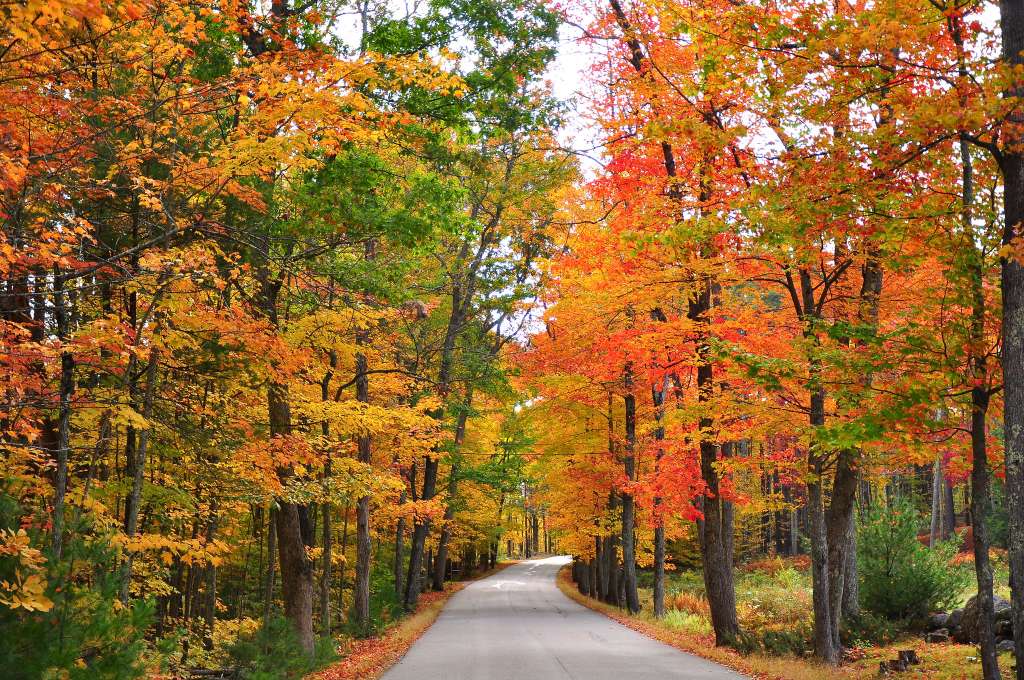(CNN) — Three years ago, Andy Finton planted a sugar maple tree — his favorite species — in his suburban Boston backyard. Each fall he waits for its leaves to change into the bright red or deep orange autumn colors the tree is known for.
That’s probably not going to happen this year.
Severe drought has been spreading and intensifying in New England this summer, prompting concerns over how vibrant the region’s fall colors show will be and whether the muted outlook could impact its multi-billion dollar fall tourism industry.
“We’re seeing stressed trees that haven’t had enough precipitation and are losing their leaves earlier,” Finton, the landscape conservation director and forest ecologist for the Nature Conservancy in Massachusetts, told CNN. “So leaves are withering, they’re drying up, and doing that fall color change before those crisp fall nights.”
All of Massachusetts, Rhode Island and Connecticut are entirely in drought, according to the US Drought Monitor, despite recent rainfall. And according to the National Oceanic and Atmospheric Administration, much of New England saw record warm temperatures in August. Together, the drought and summertime extreme temperatures have made it seem to the trees as if fall came early, said Richard B. Primack, professor of biology and plant ecology at Boston University.
“The climate is changing; and because the climate is changing, the plants are responding to that,” Primack told CNN. In a normal year, peak fall foliage usually starts between late September and is most concentrated in early to mid-October. “But in a year like this one, where there’s drought, the fall foliage is actually starting earlier.”
Fall season in New England brings around eight billion dollars in tourism revenue each year, according to the US Forest Service. People from all over the country, particularly in the Northeast, travel to the region to see the picturesque, vibrant fall foliage. But despite the changes, tour companies have yet to feel the economic impact — though conversations are happening in the industry about how the changing climate is affecting fall colors.
“We’ve discussed this very topic over the summer and recognize that the drought will indeed impact the fall colors,” Michelle Pino, vice president and co-founder of Northeast Unlimited Tours, told CNN, noting that many of the tours this year have already been booked and paid for at least a year in advance.
Primack said the changing climate also affects year-to-year variability. New England already has one of the most variable climates of any temperate region in the world, and warming temperatures are only increasing that variability.
“Every year seems to be a really different year,” he said.
Last year, for instance, was one of the wettest on record in New England. July 2021 in Massachusetts was the wettest such month in the state’s history. In contrast to this year’s drought, heavy rainfall and hot temperatures last summer put stress on the trees, prompting the leaves to change later in the season.
This year’s drought triggered an opposite kind of stress — trees haven’t had sufficient precipitation, so leaves are withering and dying much earlier.
According to Pino, the main concern this year are the tours they booked for later in October. When they planned the tours back in 2021, they booked them according to foliage prediction. But “over the course of the last decade, the foliage color arrived later and later, so we began shifting our fall tours away from later September and more into October as late as the third week,” she said. “Of course, we could never have predicted this drought.”
Finton said the perfect conditions to get the best fall color — the reds and oranges that draw leaf peepers to the Northeast — require an average amount of rain in the summer and cool fall temperatures, when nights are cold and days are bright, crisp and sunny at around 50 to 60 degrees Fahrenheit.
Much like humans, trees can detect that winter is coming, and they respond to the shift accordingly.
“The length of the daylight is the primary trigger for leaves to change color in the fall, but then the timing and the quality of fall color is very dependent on weather and the changing climate,” Finton said.
Between late September and into October, Primack explained that plants typically undergo a process called leaf senescence, which is essentially the last development stage where leaves conserve nutrients before they are damaged by frost. It can also be brought on by environmental stress like drought, extreme temperatures or too much precipitation.
If temperatures are warm and the ground stays moist from rainfall — indicators that winter is still a ways off — leaves will change color later in the season. This year is the opposite. Trees are undergoing leaf senescence and color changes earlier than normal because the plants aren’t getting enough water.
The impact of the drought is particularly stark in places that tend to be drier on average, experts say, such as areas along railroad tracks, tree-lined streets and dry rocky ridges.
“If you go out into the woods in the Boston area, you see a lot of just dead leaves on the ground right now that are just brown, so they haven’t undergone color change,” Primack said. “The conditions have been so difficult for the trees and the shrubs that the leaves have just withered on the trees, and they’ve just fallen off.”
Finton said the world needs to work together to slash planet-warming emissions and reduce the stress on the planet’s trees and forests.
And he also said that there’s still hope for fall colors in the Northeast given recent rainfall — including his backyard sugar maple tree.
“I know it’s alive and it’s still relatively healthy; and if this year isn’t its year, then next year hopefully will be,” Finton said. “Our trees and forests are very inherently resilient.”
(Copyright (c) 2024 CNN. All Rights Reserved. This material may not be published, broadcast, rewritten, or redistributed.)

